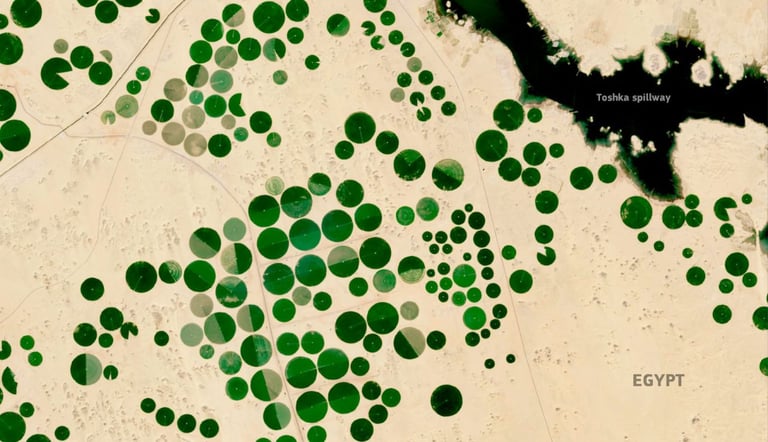Desert Farming in Egypt
Turning Arid Land into Green Fields
BLOG POSTS
Fayrouz Mahmoud
Source: European Union, Copernicus Sentinel-2 imagery


Egypt faces a pressing food security challenge, with a growing population of over 110 million people and heavy dependence on food imports. The country’s limited arable land along the Nile Valley and Delta is under immense pressure due to urban expansion, climate change, and water scarcity. Expanding agriculture into the desert is not just an option—it is a necessity. Several large-scale projects are currently underway, but the question remains: Can desert farming be both successful and sustainable?
Expanding Farmland into the Desert
Egypt’s government has launched ambitious initiatives to expand agricultural land into desert regions. The 1.5 million feddan project aims to develop 630,000 hectares of farmland by tapping into underground water reserves from the Nubian Sandstone Aquifer System—one of the largest fossil water sources in the world. Investors have been granted large plots in al-Farafra depression, where crops such as wheat, corn, and potatoes are cultivated.
The Toshka Project, one of Egypt’s largest land reclamation efforts, demonstrates how a combination of soil enrichment and advanced irrigation can turn desert into productive farmland. The use of central pivot irrigation systems, visible in the satellite imagery, has enabled the cultivation of crops like cotton, cucumbers, tomatoes, watermelons, bananas, grapes, and wheat.
The Role of Compost in Desert Farming
A key strategy in cultivating the desert is soil enrichment through composting. At Sekem farm, a pioneering agricultural initiative 60 km northeast of Cairo, compost serves as the foundation of soil regeneration. The farm produces 8,000 tons of compost annually, ensuring high microbial activity to transform barren sand into fertile farmland.
Angela Hofmann, a farming expert at Sekem since the 1980s, recalls that when the initiative began, the land was nothing but sand. To create arable soil, they:
Planted windbreaks
Added organic matter (silt, cow manure)
Applied 44 to 54 tons of compost per hectare
Over time, this process formed a 30 cm-thick humus layer, enabling the successful cultivation of fennel, cumin, sesame, wheat, and tomatoes.
Challenges and Sustainability Concerns
Despite its potential, desert farming faces several challenges:
High land development costs
Reliance on deep groundwater extraction
Risk of soil degradation
The Nubian Sandstone Aquifer System, though vast, is non-renewable. Excessive water pumping could lead to depletion, threatening long-term sustainability. To mitigate this, desert farming must focus on:
Soil health through composting
Efficient irrigation methods
Crop rotation to prevent desertification
The Sekem model illustrates how a living humus layer improves water retention, prevents soil salinization, and enhances carbon sequestration, ensuring long-term soil fertility.
Redirecting Funding Toward Agricultural Development
While Egypt has secured major financial investments to stabilize its economy, a significant portion should be allocated to agricultural projects to address food security disparities across the country.
In March 2023, the Egyptian government announced a $35 billion investment deal with Abu Dhabi Developmental Holding Company (ADQ). This investment aims to ease near-term pressures on Egypt's balance of payments and strengthen foreign currency reserves. Additionally, Egypt has received:
$8 billion from the International Monetary Fund (IMF)
$8 billion from the European Union (EU)
While these funds primarily focus on economic stabilization, directing a portion toward large-scale agricultural projects—such as desert farming, irrigation infrastructure, and sustainable food production—could significantly enhance food security and reduce reliance on food imports.
Conclusion
Egypt’s efforts to transform its deserts into fertile farmland offer a promising solution to its agricultural challenges. By utilizing compost, improving irrigation efficiency, and investing in sustainable practices, it is possible to cultivate crops in arid regions. However, the success of these projects will depend on careful resource management, policy support, and long-term planning to ensure that desert farming remains productive and environmentally viable. With the right investments, policies, and innovations, Egypt can turn its deserts into green fields, creating a sustainable future for its growing population.
References
https://www.worldometers.info/world-population/egypt-population/
https://www.jpl.nasa.gov/images/pia24616-nubian-sandstone-aquifer-egypt/
https://thefurrow.co.uk/irrigation-cultivation-in-the-desert-sekem-egypt/
https://www.copernicus.eu/en/media/image-day-gallery/desert-agriculture-egypt
https://potatoes.news/egypt-insights-into-potato-production-processing-and-export-in-2024/
Address
No 10, Block 28023
3rd District, Obour City, Egypt
Contacts
+201100899991
Careers


Copyright © EUMENA 2024
Terms and conditions
Privacy Policy
Commercial Reg.
105282
